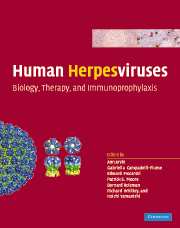Book contents
- Frontmatter
- Contents
- List of contributors
- Preface
- Part I Introduction: definition and classification of the human herpesviruses
- Part II Basic virology and viral gene effects on host cell functions: alphaherpesviruses
- Part II Basic virology and viral gene effects on host cell functions: betaherpesviruses
- Part II Basic virology and viral gene effects on host cell functions: gammaherpesviruses
- Part III Pathogenesis, clinical disease, host response, and epidemiology: HSV-1 and HSV-2
- Part III Pathogenesis, clinical disease, host response, and epidemiology: VZU
- Part III Pathogenesis, clinical disease, host response, and epidemiology: HCMV
- Part III Pathogenesis, clinical disease, host response, and epidemiology: HHV- 6A, 6B, and 7
- Part III Pathogenesis, clinical disease, host response, and epidemiology: gammaherpesviruses
- Part IV Non-human primate herpesviruses
- Part V Subversion of adaptive immunity
- Part VI Antiviral therapy
- Part VII Vaccines and immunothgerapy
- 69 Herpes simplex vaccines
- 70 Varicella-zoster vaccine
- 71 Human cytomegalovirus vaccines
- 72 Epstein–Barr virus vaccines
- 73 DNA vaccines for humanherpesviruses
- 74 Adoptive immunotherapy for herpesviruses
- 75 Immunotherapy of HSV infections – antibody delivery
- Part VIII Herpes as therapeutic agents
- Index
- Plate section
- References
70 - Varicella-zoster vaccine
from Part VII - Vaccines and immunothgerapy
Published online by Cambridge University Press: 24 December 2009
- Frontmatter
- Contents
- List of contributors
- Preface
- Part I Introduction: definition and classification of the human herpesviruses
- Part II Basic virology and viral gene effects on host cell functions: alphaherpesviruses
- Part II Basic virology and viral gene effects on host cell functions: betaherpesviruses
- Part II Basic virology and viral gene effects on host cell functions: gammaherpesviruses
- Part III Pathogenesis, clinical disease, host response, and epidemiology: HSV-1 and HSV-2
- Part III Pathogenesis, clinical disease, host response, and epidemiology: VZU
- Part III Pathogenesis, clinical disease, host response, and epidemiology: HCMV
- Part III Pathogenesis, clinical disease, host response, and epidemiology: HHV- 6A, 6B, and 7
- Part III Pathogenesis, clinical disease, host response, and epidemiology: gammaherpesviruses
- Part IV Non-human primate herpesviruses
- Part V Subversion of adaptive immunity
- Part VI Antiviral therapy
- Part VII Vaccines and immunothgerapy
- 69 Herpes simplex vaccines
- 70 Varicella-zoster vaccine
- 71 Human cytomegalovirus vaccines
- 72 Epstein–Barr virus vaccines
- 73 DNA vaccines for humanherpesviruses
- 74 Adoptive immunotherapy for herpesviruses
- 75 Immunotherapy of HSV infections – antibody delivery
- Part VIII Herpes as therapeutic agents
- Index
- Plate section
- References
Summary
Varicella vaccines: background
A live attenuated varicella vaccine, the Oka strain, was developed by Takahashi and his colleagues in Japan the early 1970s (Takahashi et al., 1974). This vaccine is now being adminstered to varicella-susceptible healthy children and adults in many countries; it is produced by at least 3 manufacturers worldwide (Merck and Co., Glaxo SmithKline, and Biken Institute/Aventis Pasteur). Although the vaccine was developed in Japan, the largest experience with it comes from the United States, where the Merck formulation was licensed for routine use in healthy susceptible individuals over the age of 1 year in 1995 (Centers for Disease Control, 1996). In both pre- and postlicensure studies (Gershon et al., 1984a, b; White, 1997; Sharrar et al., 2000) the vaccine was demonstrated to be extremely safe. Adverse effects in healthy persons are few and quite transient: a sore arm after the injection in 20%–25%, and a very minor rash resembling mild varicella in about 5%, usually appearing a month after immunization (White, 1997). A small proportion of vaccinees (15%) may also experience mild fever. It takes about a week to demonstrate antibodies to varicella-zoster virus (VZV) after immunization, but protection often results even after an exposure has occurred. As a result of widespread immunization of children, the epidemiology of varicella has begun to change in the United States, with a reported marked decline in incidence in sentinel areas, where active surveillance for the disease is being carried out (Seward et al., 2002).
- Type
- Chapter
- Information
- Human HerpesvirusesBiology, Therapy, and Immunoprophylaxis, pp. 1262 - 1273Publisher: Cambridge University PressPrint publication year: 2007
References
- 4
- Cited by

